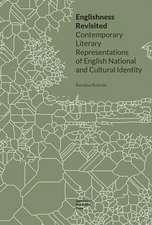Kingdoms of Memory, Empires of Ink – The Veda and the Regional Print Cultures of Colonial India
Autor Cezary Galewiczen Limba Engleză Paperback – 28 feb 2022
Preț: 318.74 lei
Nou
Puncte Express: 478
Preț estimativ în valută:
60.99€ • 63.68$ • 50.48£
60.99€ • 63.68$ • 50.48£
Carte disponibilă
Livrare economică 14-28 martie
Livrare express 27 februarie-05 martie pentru 37.16 lei
Preluare comenzi: 021 569.72.76
Specificații
ISBN-13: 9788323343912
ISBN-10: 8323343918
Pagini: 306
Dimensiuni: 158 x 234 x 17 mm
Greutate: 0.5 kg
Editura: Jagiellonian University Press
ISBN-10: 8323343918
Pagini: 306
Dimensiuni: 158 x 234 x 17 mm
Greutate: 0.5 kg
Editura: Jagiellonian University Press
Notă biografică
Cezary Galewicz, Associate Professor in Centre for Comparative Studies of Civilisations at the Jagiellonian University, Krakow, Poland. A historian of civilisations; a researcher exploring contemporary forms of cultural, religious and literary traditions of South Asia; member and coordinator of international research teams; translator.
Cuprins
Preface
Introduction
I. Objects, Spaces and Practices
I.1. The Book as an object circulating in space
I.2. The Rebel Book of the Veda
II. The Veda Before Print
II.1 The Beginnings: the travelling Veda
II.2 The living libraries: the memorized Veda
II.3 Performance and spectacle: The ritual Veda
II.4 Scribes and scripture: the handwritten Veda
II.5. The Veda commented upon
II.5.1. The imperial commentary
II.6 The Veda in the empire of writing
III.The Coming of Print to Indian Subcontinent
III.1 The Missionary, the Government and the Commercial Printers
III.2 Preachers, printers and Pundits
III.2.1The Jesuit printers of the western coast
III.2.2 German Danish Evangelists on the Coromandel Coast
III.2.3 The media revolution of Serampore 1800 ¿1837
III.2.4 Later Missionary print cultures
III.3 The Empire in print and the Ethnographic State
III.3.1 The Infernal machine
III.3.2 The Government Press and imperial typography
III.3.3 Print, catalogues and native knowledge
III.3.4 The ethnographic state in print
III.4 Indian Commercial Printing after 1835 (New Beginnings)
IV.The Printed Veda
IV.1 The lost, imagined and recovered Veda
IV.2. The Philological Veda
IV.3. The Imperial Veda
IV.3.1. Max Muller and his patrons
IV.4. The Printed Veda for Pä¿itas and Pundits
IV.5. The Veda printed in India
IV.5.1 The polluting ink
IV.5.2 Whose is the printed Veda
IV.5.3. The codex and the pothi
V. The reading practices
V.1. The cultural concepts and practices of reading
V.1.1 The sv¿dhy¿ya and the brahma-yajña
V.1.2 brahmavidy¿-d¿na
V.1.3 The vidh¿na tradition
V.2. The regional practices of reading the Veda
V.2.1 Modus legendi: däagrantha
V.2.2 Modus legendi: the veda-p¿r¿yäa
V.2.3 Modus legendi: the trisandh¿
VI. Towards Social history of print cultures in colonial India
VI.1. Printing revolution and social change
VI.2 Publishing Indian Religions in Print
VI.2.1 Printing and Appropriation of the past
VI.3 The regional print cultures and the Veda
ABBREVIATIONS
REFERENCES
INDEX
Introduction
I. Objects, Spaces and Practices
I.1. The Book as an object circulating in space
I.2. The Rebel Book of the Veda
II. The Veda Before Print
II.1 The Beginnings: the travelling Veda
II.2 The living libraries: the memorized Veda
II.3 Performance and spectacle: The ritual Veda
II.4 Scribes and scripture: the handwritten Veda
II.5. The Veda commented upon
II.5.1. The imperial commentary
II.6 The Veda in the empire of writing
III.The Coming of Print to Indian Subcontinent
III.1 The Missionary, the Government and the Commercial Printers
III.2 Preachers, printers and Pundits
III.2.1The Jesuit printers of the western coast
III.2.2 German Danish Evangelists on the Coromandel Coast
III.2.3 The media revolution of Serampore 1800 ¿1837
III.2.4 Later Missionary print cultures
III.3 The Empire in print and the Ethnographic State
III.3.1 The Infernal machine
III.3.2 The Government Press and imperial typography
III.3.3 Print, catalogues and native knowledge
III.3.4 The ethnographic state in print
III.4 Indian Commercial Printing after 1835 (New Beginnings)
IV.The Printed Veda
IV.1 The lost, imagined and recovered Veda
IV.2. The Philological Veda
IV.3. The Imperial Veda
IV.3.1. Max Muller and his patrons
IV.4. The Printed Veda for Pä¿itas and Pundits
IV.5. The Veda printed in India
IV.5.1 The polluting ink
IV.5.2 Whose is the printed Veda
IV.5.3. The codex and the pothi
V. The reading practices
V.1. The cultural concepts and practices of reading
V.1.1 The sv¿dhy¿ya and the brahma-yajña
V.1.2 brahmavidy¿-d¿na
V.1.3 The vidh¿na tradition
V.2. The regional practices of reading the Veda
V.2.1 Modus legendi: däagrantha
V.2.2 Modus legendi: the veda-p¿r¿yäa
V.2.3 Modus legendi: the trisandh¿
VI. Towards Social history of print cultures in colonial India
VI.1. Printing revolution and social change
VI.2 Publishing Indian Religions in Print
VI.2.1 Printing and Appropriation of the past
VI.3 The regional print cultures and the Veda
ABBREVIATIONS
REFERENCES
INDEX

